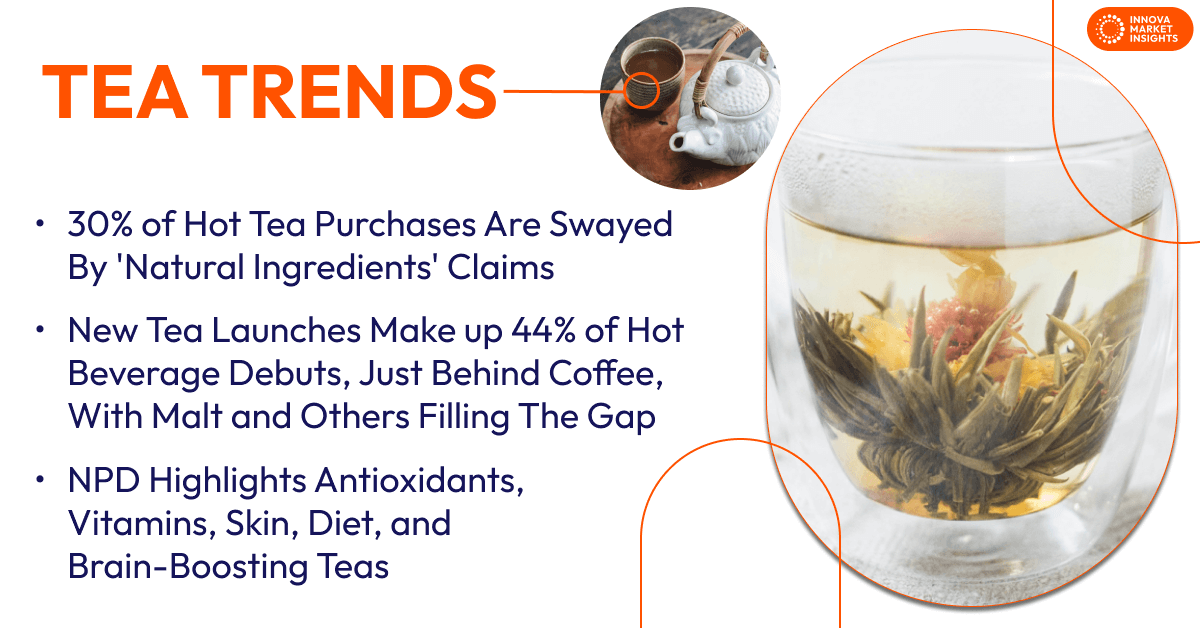March 8, 2024 – In the ever-evolving world of hot beverages, tea has carved out a significant market niche, captivating consumers with its blend of tradition, health benefits and innovative flavors. With the global hot beverage market valued at an impressive $150 billion, tea accounts for a substantial one-third of this figure, underscoring its enduring popularity and potential for growth. When analyzing tea trends, several key themes emerge, highlighting consumers’ affinity for natural ingredients, organic options and health-promoting properties.
Tea’s Natural Appeal
In the hot tea category, 30% of consumer purchase decisions are most influenced by the claim “made with natural/real ingredients.” Companies are responding to this demand, and when looking at claims in tea trends, natural and no additives/preservatives claims show a growth rate (CAGR) of +11% and +6% respectively over the past three years. Organic claims are up 19% and the use of naturally flavored ingredients such as cinnamon, chamomile, peppermint, rose hips, orange peel and lemon are also on the rise. Products with natural sweeteners (stevia, monk fruit, honey) and hand-picked tea leaves are driving new product introductions.
Tea: An Innovative and Growing Category
Sales value growth in the tea category is higher than hot beverages overall. New tea launches account for 44% of all hot beverage launches, only slightly less than coffee, with malt and other hot beverages making up the difference. Two areas to watch in tea trends are fermented teas and caffeine-free options.
Asia Pacific is the top region for both tea NPD and value sales, with the highest CAGR for value sales. 40% of all tea launches over the past three years were in this region. Vegetarian is the top positioning claim for tea launches in Asia, and new launches include the use of a range of leaves (peppermint, spearmint, senna leaves, pearl grass) and spices (pepper, temulawak) for digestive/gut health.
The Middle East/Africa (MEA) region is the highest innovation and value growth market for tea in 2021-2023, with the highest CAGR of +22.1% over the past three years. Contributing to the growth are halal and kosher options, the use of premium tea leaves from Kenya, authentic Arabic flavored preparations and inspired ranges (Chinese green tea, Ceylon black tea).

Driving Innovation: The Health and Wellness Trend
Health is an important driver of tea trends. Products targeting brain health, skin health, weight management and energy are gaining traction, reflecting a consumer base that is increasingly aware of the health implications of their dietary choices. The introduction of teas fortified with ingredients such as garcinia cambogia, ashwagandha and turmeric underscores the industry’s commitment to meeting these wellness trends.
The market has seen a surge in health-related positioning, with claims focusing on antioxidant, vitamin and mineral fortification. Growing health-related positionings in all regions are antioxidant, vitamin/mineral fortification, brain health (North America), skin health, weight management (MEA) and energy/alertness (Europe). NPD includes antioxidant rich formulations supported by the presence of polyphenols, catechins and flavonoids in tea, vitamin/mineral fortified launches (vitamins C, B3, D), skin health offerings with apple blossom tea, diet conscious formulations (with garcinia cambogia, guarana) and memory and mental focus ingredients (turmeric, moringa, ginkgo).
Flavor Trends in Tea
The flavor landscape of the tea market is also changing, with lemon the fastest growing of the top five tea flavors. The growing popularity of floral, fruit and spice flavors highlights consumers’ appetite for variety and experimentation. Regions are diversifying their flavor profiles, from North America’s interest in lemon balm to the Middle East’s preference for authentic Arabic flavors.
Also on the rise are floral flavors such as moringa (flower) (North America), chrysanthemum (APAC), jasmine (LATAM), lime blossom (MEA); fruit flavors such as mango, blueberry, pear, pomegranate, jujube; and spices such as turmeric and anise. Similarly, NPD in MEA includes floral (rose, jasmine, hibiscus), fruit (mango, red raspberry, citrus, strawberry, peach) and herbal (lemon balm, lemongrass).
What’s Next in Tea Trends?
As the tea market continues to evolve, it’s clear that consumer preferences for natural ingredients, health benefits and innovative flavors are driving the industry toward a future of growth and diversification. The adoption of organic options, coupled with a growing interest in a wide range of flavors and health-oriented products, underscores a global shift towards more conscious consumption.
With regions such as Asia Pacific and the Middle East/Africa leading the way in innovation and growth, the tea industry is on a promising trajectory, offering a wealth of opportunities for both traditional tea lovers and those seeking new experiences. As we look to the future of tea trends, the tea market’s blend of tradition and innovation is poised to captivate an even wider audience, promising a rich, flavorful and healthy journey into the world of tea.
This article is based on our report, “What’s Trending in Tea – Global.” If you are interested in reading this report, feel free to request a demo.
You can do this by either booking a demo or using our Contact Form.